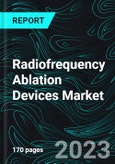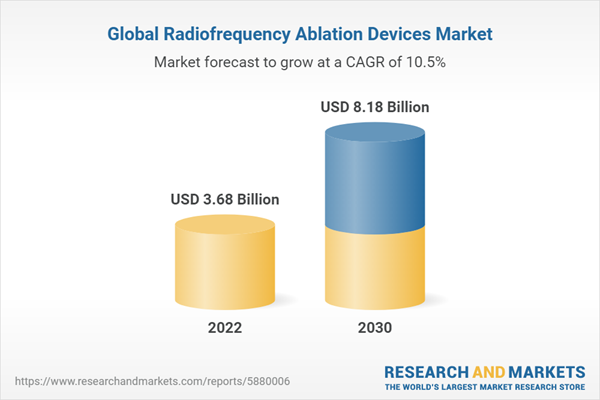According to the World Health Organization in 2023, cardiovascular diseases (CVDs) stand as the primary cause of mortality globally, accounting for approximately 17.9 million lives annually. These diseases encompass a range of conditions primarily affecting the coronary heart and blood vessels, including coronary heart sickness, rheumatic heart sickness, cerebro vascular sickness, among others.
Furthermore, data from the World Heart Foundation predicts that by the end of 2030, approximately 14-17 million individuals in the European Union will be living with atrial fibrillation, with an anticipated 12 million instances in the United States. Radiofrequency ablation devices are a broadly used method in the treatment of atrial traumatic inflammation (AFib). Consequently, the escalating worldwide occurrence of cardiovascular diseases, which include atrial fibrillation, is poised to drive the demand for radiofrequency ablation devices, thereby contributing to the growth of the global industry for such devices.
Radiofrequency Ablation Devices Market is predicated to grow at a CAGR of 10.50% throughout the forecast duration 2022-2030
Another significant component driving the enlargement of the radiofrequency ablation devices market is the growing prevalence of various cancers types. Among those, liver cancers one of the commonest types of cancer and radiofrequency ablation device is utilized as one of the treatment approaches. According to the GLOBOCAN 2020, there were 905,677 new cases of liver cancers and around 830,180 related deaths happened worldwide. While radiofrequency ablation won't be the primary treatment for cancers, it's far used as either an adjunctive treatment or is suggested on case-to-case basis. Consequently, the growing incidence of cancers with diverse causes is anticipated to make contributions to the developing demand for radiofrequency ablation devices, propelling the radiofrequency ablation devices market forward within the forecast period.The developing healthcare expenditure and a preference for minimally invasive surgical processes are significant driving factors behind market growth. According to the U.S. Census Bureau, worldwide healthcare spending is projected to attain USD 18.28 trillion via 2040, with a compound annual increase charge (CAGR) of 2.6%. This predicted increase in healthcare spending is poised to have an effective effect at the revenue generated from radiofrequency ablation devices.
Additionally, the rising prevalence of chronic pain conditions like arthritis and osteoporosis, combined with improvements in healthcare infrastructure, will similarly propel radiofrequency ablation device market growth. According to the U.S. Department of Health & Human Services, in 2015, about 15 million adults had been experiencing severe joint pain because of arthritis. By 2040, it is estimated that around 78 million (26% of) U.S. Adults elderly 18 years and above can be identified with arthritis. Global Radiofrequency Ablation Devices Market was valued at US$ 3.68 billion in 2022.
Disposable radiofrequency ablation device leads the market due to healthcare choice for single-use devices, driven by heir numerous advantages
By Product Type, Radiofrequency Ablation Devices Market is segmented into Capital Equipment, Disposable Equipment and Reusable Equipment. Disposable radiofrequency ablation equipment controls the largest market share, reflecting the healthcare industry's developing preference for single-use devices. Disposable enhances protection by reducing the danger of cross-contamination and infection transmission between the patients. It streamlines healthcare workflows by getting rid of the need for time-consuming and highly-priced sterilization processes. Disposable devices require much less upkeep and calibration, simplifying operations for healthcare companies. This dominance of disposable device can be attributed to its value-effectiveness and comfort, making it a favored desire for hospitals, clinics, and surgical facilities. As healthcare facilities are seeking for progressed efficiency, stringent hygiene standards, and fee control, disposable radiofrequency ablation device continues to advantage prominence, establishing a great foothold in this unexpectedly evolving area.Cardiology segment dominates Radiofrequency Ablation Devices Market
By Application, Radiofrequency Ablation Devices Market is divided into Oncology, Cardiology, Cosmetic Surgery, Gynecology and Others. The growth of radiofrequency ablation in cardiology is propelled by its amazing effectiveness and minimally invasive technique. This commanding presence is commonly attributed to the critical role that radiofrequency ablation plays in treating various diseases including atrial fibrillation, ventricular tachycardia, and other arrhythmias. Cardiologists broadly utilize radiofrequency ablation devices to restore normal heart rhythm and alleviate symptoms, making it a fundamental device of their arsenal. The growing occurrence of cardiovascular diseases worldwide, coupled with advancements in ablation techniques and technologies, further bolsters the cardiology segment prominence in the Radiofrequency Ablation Devices market. As the demand for minimally invasive cardiac techniques keeps the upward thrust, the cardiology segment is expected to grow in future.Ambulatory Surgical Centers (ASCs) occupies a dominant position in the radiofrequency ablation device industry
By End User, Radiofrequency Ablation Devices Market is classed into Hospitals, Ambulatory Surgical Centers & Others. Ambulatory Surgical Centers (ASC’s) have pivotal market share in the Radiofrequency Ablation Devices industry. Patients pick ASCs for radiofrequency ablation devices due to shorter wait times and outpatient comfort. These centers excel in performance and are best for minimally invasive methods. Increasing demand for radiofrequency ablation, fueled through factors like growing older populations and rising cardiac arrhythmias, elevates ASCs' importance, contributing significantly to enterprise growth.Also, Hospitals are vital in the Radiofrequency Ablation Devices industry, offering expertise, advanced facilities, and specialized care. They are primary in treating complicated conditions via radiofrequency ablation, playing a pivotal role in the industry's increase and patient care globally.United States Radiofrequency Ablation Devices Industry has witnessed splendid growth and innovation
By Country, Radiofrequency Ablation Devices Market is split into United States, Canada, Mexico, Brazil, United Kingdom, Germany, France, Italy, Spain, Netherlands, China, Japan, India, South Korea, Australia, South Africa, United Arab Emirates and Rest of World. In the US, the Radiofrequency Ablation Devices industry has surged due to elements like growing chronic ache situations and cardiac arrhythmias. Radiofrequency ablation is favored for its effectiveness and minimally invasive nature, aligning with a robust healthcare ecosystem. This surge is propelled by the increasing prevalence of chronic diseases, specifically cardiovascular conditions and cancers, frequently treated with radiofrequency ablation devices. Additionally, the market benefits from the choice for minimally invasive procedures and a growing older population. Technological improvements and rising healthcare spending cement the US' pivotal position within the worldwide radiofrequency ablation devices market.The China radiofrequency ablation device market is ready for substantial growth. This is driven via a rapidly expanding healthcare area, growing consciousness of minimally invasive treatments, and a growing elderly populace. These radiofrequency ablation devices find widespread use in oncology and cardiology to address conditions like tumors and arrhythmias. Additionally, ongoing technological advancements and healthcare infrastructure development will increase the market, offering enormous opportunities for home and global healthcare manufacturers.
Key Players
Boston Scientific Corporation Inc, Abbott Laboratories, AtriCureInc, Medtronic Plc, Stryker, Smith & Nephew Plc, Conmed Corporation and HologicInc are the predominant companies in the Radiofrequency Ablation Devices Market.The report 'Radiofrequency Based Devices Market, Global Forecast By Product (Capital Equipment, Disposable Equipment & Reusable Equipment), Application (Oncology, Cardiology, Cosmetic Surgery, Gynecology & Others), End-User (Hospitals, Ambulatory Surgical Centers &Others), Region (North America, Europe, Asia Pacific, Latin America and Middle East Africa), Companies (Boston Scientific Corporation Inc, Abbott Laboratories, AtriCureInc, Medtronic Plc, Stryker, Smith & Nephew Plc, Conmed Corporation and HologicInc)' provides a detailed analysis of Radiofrequency Ablation Devices Industry.
Product - Breakup Covered from 3 viewpoints:
1. Capital Equipment2. Disposable Equipment
3. Reusable Equipment
Application - Breakup Covered from 5 viewpoints:
1. Oncology2. Cardiology
3. Cosmetic Surgery
4. Gynecology
5. Others
End User - Breakup Covered from 3 viewpoints:
1. Hospitals2. Ambulatory Surgical Centers
3. Others
Region - Breakup Covered from 5 viewpoints:
1. North America
1.1 United States1.2 Canada
2. Latin America
2.1 Mexico2.2 Brazil
3. Europe
3.1 United Kingdom3.2 Germany
3.3 France
3.4 Italy
3.5 Spain
3.6 Netherlands
4. Asia Pacific
4.1 China4.2 Japan
4.3 India
4.4 South Korea
4.5 Australia
5. Middle East & Africa
5.1 United Arab Emirates5.2 South Africa
6. Rest of the World
Company Insights:
- Overview
- Recent Development
- Revenue
Key Players:
1. Boston Scientific Corporation Inc2. Abbott Laboratories
3. AtriCureInc
4. Medtronic Plc
5. Stryker
6. Smith & Nephew Plc
7. Conmed Corporation
8. HologicInc
Table of Contents
Companies Mentioned
- Boston Scientific Corporation Inc
- Abbott Laboratories
- AtriCureInc
- Medtronic Plc
- Stryker
- Smith & Nephew Plc
- Conmed Corporation
- HologicInc
Methodology
In this report, for analyzing the future trends for the studied market during the forecast period, the publisher has incorporated rigorous statistical and econometric methods, further scrutinized by secondary, primary sources and by in-house experts, supported through their extensive data intelligence repository. The market is studied holistically from both demand and supply-side perspectives. This is carried out to analyze both end-user and producer behavior patterns, in the review period, which affects price, demand and consumption trends. As the study demands to analyze the long-term nature of the market, the identification of factors influencing the market is based on the fundamentality of the study market.
Through secondary and primary researches, which largely include interviews with industry participants, reliable statistics, and regional intelligence, are identified and are transformed to quantitative data through data extraction, and further applied for inferential purposes. The publisher's in-house industry experts play an instrumental role in designing analytic tools and models, tailored to the requirements of a particular industry segment. These analytical tools and models sanitize the data & statistics and enhance the accuracy of their recommendations and advice.
Primary Research
The primary purpose of this phase is to extract qualitative information regarding the market from the key industry leaders. The primary research efforts include reaching out to participants through mail, tele-conversations, referrals, professional networks, and face-to-face interactions. The publisher also established professional corporate relations with various companies that allow us greater flexibility for reaching out to industry participants and commentators for interviews and discussions, fulfilling the following functions:
- Validates and improves the data quality and strengthens research proceeds
- Further develop the analyst team’s market understanding and expertise
- Supplies authentic information about market size, share, growth, and forecast
The researcher's primary research interview and discussion panels are typically composed of the most experienced industry members. These participants include, however, are not limited to:
- Chief executives and VPs of leading corporations specific to the industry
- Product and sales managers or country heads; channel partners and top level distributors; banking, investment, and valuation experts
- Key opinion leaders (KOLs)
Secondary Research
The publisher refers to a broad array of industry sources for their secondary research, which typically includes, however, is not limited to:
- Company SEC filings, annual reports, company websites, broker & financial reports, and investor presentations for competitive scenario and shape of the industry
- Patent and regulatory databases for understanding of technical & legal developments
- Scientific and technical writings for product information and related preemptions
- Regional government and statistical databases for macro analysis
- Authentic new articles, webcasts, and other related releases for market evaluation
- Internal and external proprietary databases, key market indicators, and relevant press releases for market estimates and forecasts

LOADING...
Table Information
| Report Attribute | Details |
|---|---|
| No. of Pages | 170 |
| Published | September 2023 |
| Forecast Period | 2022 - 2030 |
| Estimated Market Value ( USD | $ 3.68 Billion |
| Forecasted Market Value ( USD | $ 8.18 Billion |
| Compound Annual Growth Rate | 10.5% |
| Regions Covered | Global |
| No. of Companies Mentioned | 8 |









